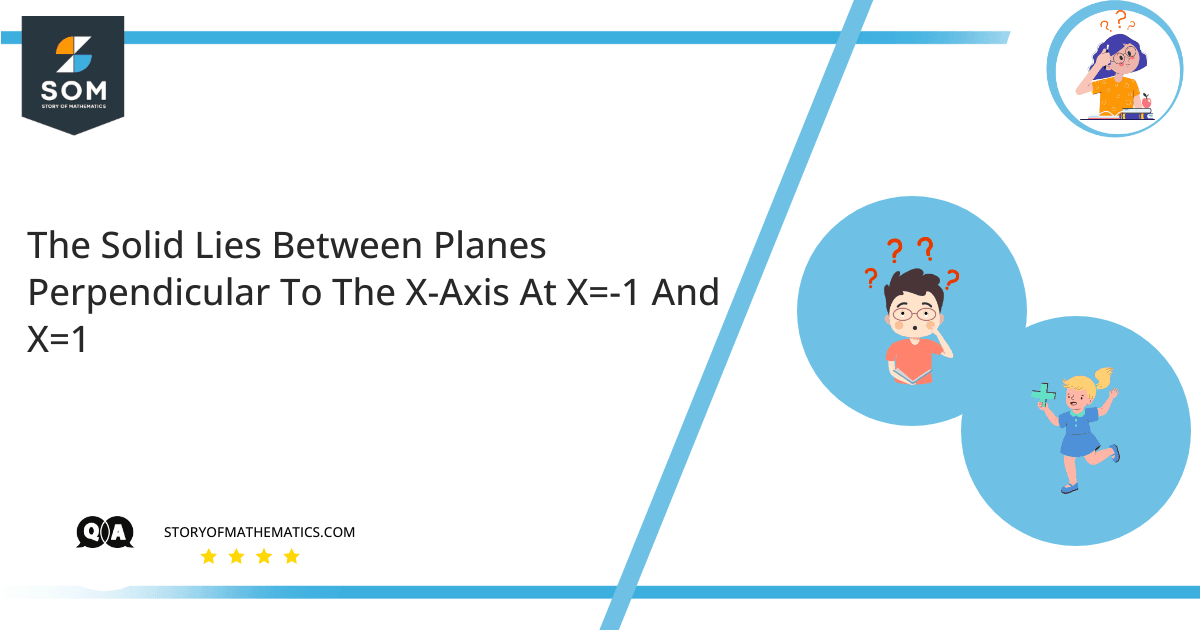
– A Square is formed from the cross-section of given two planes perpendicular to the $x-axis$. Base of this square extends from one semicircle $y=\sqrt{1-x^2}$ to another semicircle $y=-\sqrt{1-x^2}$. Find the volume of the solid.
The main purpose of this article is to find the volume of the given solid that is lying between two planes perpendicular to the $x-axis$.
The basic concept behind this article is the Slicing Method to calculate the volume of a solid. It involved the slicing of the given solid which results in cross-sections having uniform shapes. The Differential Volume of each slice is the area of cross-section multiplied by its differential length. And the total volume of the solid is calculated by the sum of all the differential volumes.
Expert Answer
Given that:
The solid that lies across the $x-axis$ from $x=-1$ to $x=1$.
Two semicircles are represented by:
\[y_1=\sqrt{1-x^2} \]
\[y_2=-\sqrt{1-x^2} \]
A Square is formed from the cross-section of given two planes perpendicular to the $x-axis$. Base $b$ of the square will be:
\[b=y_1-y_2 \]
\[b=\sqrt{1-x^2}-(-\sqrt{1-x^2}) \]
\[b=2\sqrt{1-x^2} \]
Cross-sectional Area $A$ of the square is:
\[A=b\times b=b^2 \]
\[A(x)={(2\sqrt{1-x^2})}^2 \]
\[A(x)=4(1-x^2) \]
To find the volume of the solid, we will use the differential with limits of integration ranging from $x=-1$ to $x=1$.
\[Volume\ V(x)=\int_{-1}^{1}{A(x)dx} \]
\[V(x)=\int_{-1}^{1}{4(1-x^2)dx} \]
\[V(x)=4\int_{-1}^{1}{(1-x^2)dx} \]
\[V(x)=4\left[\int_{-1}^{1}{(1)dx-\int_{-1}^{1}{(x}^2)dx}\right] \]
\[V(x)=4\left[x-\frac{1}{3}x^2\right]_{-1}^1 \]
\[V(x)=4\left(1-\frac{1}{3}{(1)}^2\right)-4\left(-1-\frac{1}{3}{(-1)}^2\right) \]
\[V(x)=4\left(\frac{2}{3}\right)-4\left(-\frac{2}{3}\right) \]
\[V(x)=\frac{8}{3}+\frac{8}{3} \]
\[V(x)=\frac{16}{3} \]
Numerical Result
The volume of the solid that lies between planes perpendicular to the $x -axis$ is $\dfrac{16}{3}$.
\[Volume\ V(x)=\frac{16}{3} \]
Example
A solid body exists between the planes that are perpendicular to the $x-axis$ at $x=1$ to $x=-1$.
A circular disk is formed from the cross-section of given two planes perpendicular to the $x-axis$. The diameters of these circular disks extend from one parabola $y={2-x}^2$ to another parabola $y=x^2$. Find the volume of the solid.
Solution
Given that:
The solid that lies across the $x-axis$ from $x=1$ to $x=-1$.
Two parabolas are represented by:
\[y_1=2-x^2\]
\[y_2=x^2\]
A circular disk is formed from the cross-section of given two planes perpendicular to the $x-axis$. The diameter $d$ of the circular disk will be:
\[d=y_1-y_2\]
\[d=2-x^2-x^2\]
\[d\ =\ 2-{2x}^2\]
As we know that radius of a circle is:
\[r\ =\ \frac{1}{2}d\]
\[r\ =\ \frac{1}{2}\ (2-{2x}^2)\]
\[r\ =\ 1-x^2\]
Cross-sectional Area $A$ of the circle is:
\[A=\ \pi\ r^2\]
\[A(x)\ =\ {\pi\ (1-x^2)}^2\]
To find the volume of the solid, we will use the differential with limits of integration ranging from $x\ =\ 1$ to $x\ =\ -1$.
\[Volume\ V(x)\ =\ \int_{-1}^{1}{A(x)\ dx}\]
\[V\left(x\right)\ =\ \int_{-1}^{1}{{\pi\left(1-x^2\right)}^2\ dx}\]
\[V\left(x\right)\ =\ \pi\int_{-1}^{1}{(1-{2x}^2+x^4)\ dx}\]
\[V(x)\ =\ \pi\left[\int_{-1}^{1}{(1)\ dx-2\int_{-1}^{1}{(x}^2)\ dx+\int_{-1}^{1}{(x}^4)\ dx}\right]\]
\[V(x)\ =\ \pi\ \left[x-\frac{2}{3}x^3+\frac{1}{5}x^5\right]_{-1}^1\]
\[V(x)\ =\ \pi\ \left(1\ -\ \frac{2}{3}{\ (1)}^3\ +\ \frac{1}{5}{\ (1)}^5\right)\ -\ \pi\ \left(-1\ -\ \frac{2}{3}{\ (-1)}^3\ +\ \frac{1}{5}{\ (-1)}^5\right)\]
\[V(x)\ =\ \pi\ \left(\frac{8}{15}\right)\ -\ \pi\ \left(-\frac{8}{15}\right) \]
\[V(x)\ =\ \frac{8}{15}\ \pi\ +\ \frac{8}{15}\ \pi \]
\[V(x)\ =\ \frac{16}{15}\ \pi \]
Hence, the Volume of the solid that lies between planes perpendicular to the $x -axis$ is $\dfrac{16}{15}\ \pi$.
\[Volume\ V(x)\ =\ \frac{16}
{15}\ \pi \]
